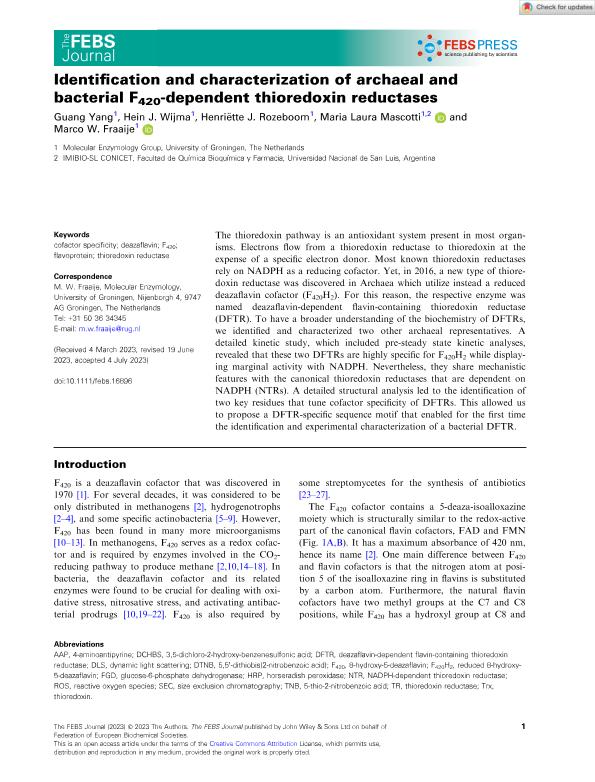Mostrar el registro sencillo del ítem
dc.contributor.author
Yang, Guang
dc.contributor.author
Wijma, Hein J.
dc.contributor.author
Rozeboom, Henriëtte J.
dc.contributor.author
Mascotti, María Laura

dc.contributor.author
Fraaije, Marco Wilhelmus

dc.date.available
2024-02-19T12:39:47Z
dc.date.issued
2023-07
dc.identifier.citation
Yang, Guang; Wijma, Hein J.; Rozeboom, Henriëtte J.; Mascotti, María Laura; Fraaije, Marco Wilhelmus; Identification and characterization of archaeal and bacterial F420-dependent thioredoxin reductases; Wiley Blackwell Publishing, Inc; Febs Journal; 290; 19; 7-2023; 4777-4791
dc.identifier.issn
1742-464X
dc.identifier.uri
http://hdl.handle.net/11336/227399
dc.description.abstract
The thioredoxin pathway is an antioxidant system present in most organisms. Electrons flow from a thioredoxin reductase to thioredoxin at the expense of a specific electron donor. Most known thioredoxin reductases rely on NADPH as a reducing cofactor. Yet, in 2016, a new type of thioredoxin reductase was discovered in Archaea which utilize instead a reduced deazaflavin cofactor (F420H2). For this reason, the respective enzyme was named deazaflavin-dependent flavin-containing thioredoxin reductase (DFTR). To have a broader understanding of the biochemistry of DFTRs, we identified and characterized two other archaeal representatives. A detailed kinetic study, which included pre-steady state kinetic analyses, revealed that these two DFTRs are highly specific for F420H2 while displaying marginal activity with NADPH. Nevertheless, they share mechanistic features with the canonical thioredoxin reductases that are dependent on NADPH (NTRs). A detailed structural analysis led to the identification of two key residues that tune cofactor specificity of DFTRs. This allowed us to propose a DFTR-specific sequence motif that enabled for the first time the identification and experimental characterization of a bacterial DFTR.
dc.format
application/pdf
dc.language.iso
eng
dc.publisher
Wiley Blackwell Publishing, Inc

dc.rights
info:eu-repo/semantics/openAccess
dc.rights.uri
https://creativecommons.org/licenses/by/2.5/ar/
dc.subject
COFACTOR SPECIFICITY
dc.subject
DEAZAFLAVIN
dc.subject
F420
dc.subject
FLAVOPROTEIN
dc.subject
THIOREDOXIN REDUCTASE
dc.subject.classification
Bioquímica y Biología Molecular

dc.subject.classification
Ciencias Biológicas

dc.subject.classification
CIENCIAS NATURALES Y EXACTAS

dc.title
Identification and characterization of archaeal and bacterial F420-dependent thioredoxin reductases
dc.type
info:eu-repo/semantics/article
dc.type
info:ar-repo/semantics/artículo
dc.type
info:eu-repo/semantics/publishedVersion
dc.date.updated
2024-02-19T10:33:53Z
dc.journal.volume
290
dc.journal.number
19
dc.journal.pagination
4777-4791
dc.journal.pais
Reino Unido

dc.journal.ciudad
Londres
dc.description.fil
Fil: Yang, Guang. University of Groningen; Países Bajos
dc.description.fil
Fil: Wijma, Hein J.. University of Groningen; Países Bajos
dc.description.fil
Fil: Rozeboom, Henriëtte J.. University of Groningen; Países Bajos
dc.description.fil
Fil: Mascotti, María Laura. Consejo Nacional de Investigaciones Científicas y Técnicas. Centro Científico Tecnológico Conicet - San Luis. Instituto Multidisciplinario de Investigaciones Biológicas de San Luis. Universidad Nacional de San Luis. Facultad de Ciencias Físico Matemáticas y Naturales. Instituto Multidisciplinario de Investigaciones Biológicas de San Luis; Argentina. University of Groningen; Países Bajos
dc.description.fil
Fil: Fraaije, Marco Wilhelmus. University of Groningen; Países Bajos
dc.journal.title
Febs Journal

dc.relation.alternativeid
info:eu-repo/semantics/altIdentifier/url/https://febs.onlinelibrary.wiley.com/doi/10.1111/febs.16896
dc.relation.alternativeid
info:eu-repo/semantics/altIdentifier/doi/http://dx.doi.org/10.1111/febs.16896
Archivos asociados
